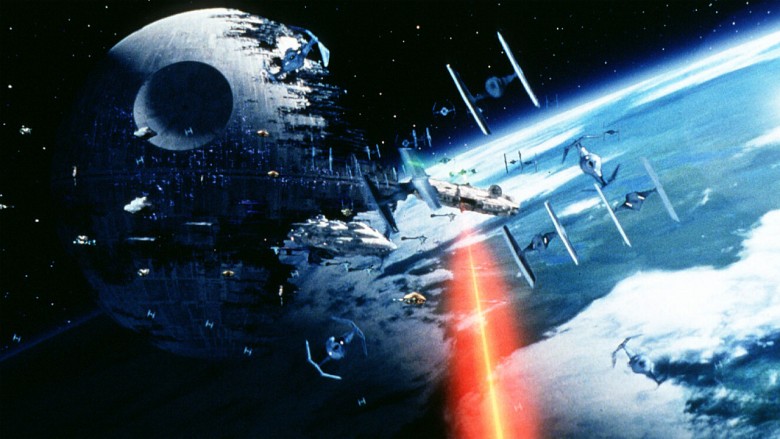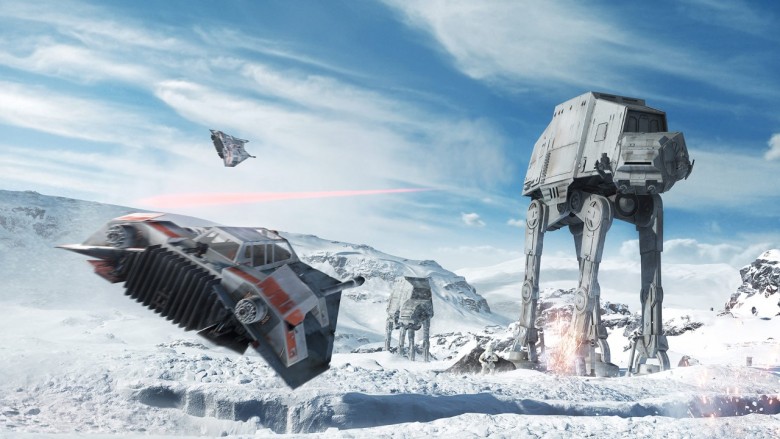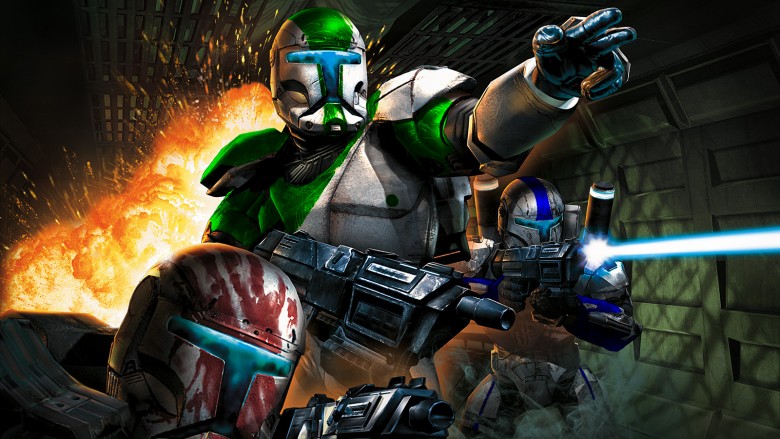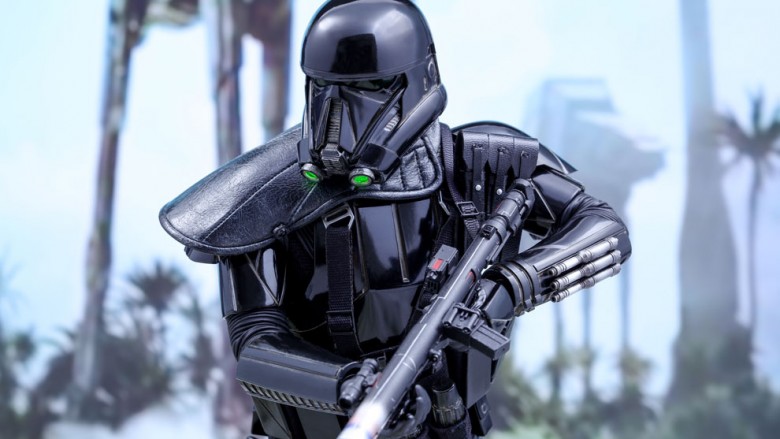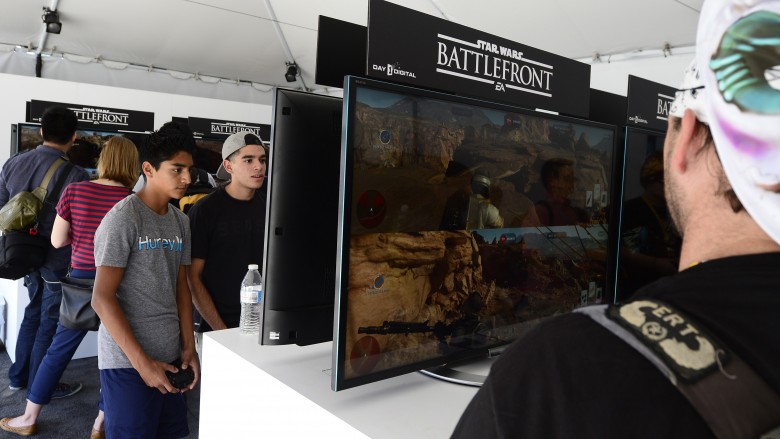What We Need To See In Star Wars: Battlefront 2
After a decade of waiting, Star Wars fans finally got a new Battlefront game in 2015, but it came with a few shortcomings. In order for players to maintain interest in DICE's upcoming sequel, some changes need to be made.
Space battles
Space battles are an inherent part of the Star Wars universe. Every movie has featured at least one—which makes sense since, you know, the words "star" and "wars" are in the name. However, the closest Battlefront came was in the Fighter Squadron mode, in which players would pilot either an Imperial or Alliance ship and fight each other less than a mile above ground.
In the sequel, the studio should include maps that allow players to engage in a form of space battle, or at least incorporate maps set in space in the Fighter Squadron mode. If DICE goes with the former, they should build maps that allow players to spawn on a ship, pilot a starfighter, and either shoot or board the enemy. Unfortunately, the 2015 installment didn't allow for such intricate battle scenarios, and that's where it faltered—at least in the eyes of longtime fans.
Single-player campaign
With the current rise in online play, it seems like more studios are forgoing single-player campaigns for multiplayer-only games such as Titanfall, Destiny, The Division, and Star Wars: Battlefront. The lack of a story mode negatively affected Battlefront for players—even in the eyes of Star Wars: The Force Awakens star John Boyega, who asked EA about including a story mode.
The original games had three single-player modes, including Galactic Conquest, a mode in which players could coordinate and execute, literally, a conquest across the galaxy. No matter how players went about it, there was at least some semblance of strategy involved. While there have been some rumblings of DICE including a single-player campaign in the next installment, we don't know what the campaign would entail.
Sure, multiplayer in Battlefront is fun, but Star Wars is about the narrative, and a proper story mode is needed to experience it. Developers are learning that, which is why Titanfall 2 now includes a story mode—and why Battlefront 2 needs one.
More locations
Battlefront originally released with 12 multiplayer maps, a hefty amount considering that the studio's latest release, Battlefield 1, only had nine maps at launch. The difference between the games, however, is that each map in Battlefield 1 featured an entirely new environment, whereas each map in Battlefront was a variation of one of the four planets included in the base game: Hoth, Endor, Sullust, and Tatooine. Players felt cheated, and it contributed to criticisms of lack of content. There are hundreds, if not thousands, of known planets in the Star Wars galaxy, some of which were introduced in Rogue One, and the DICE team should use a handful to expand the core content, not tack them on in post-game DLC.
No vehicle token system
DICE made a conscious effort to differentiate Star Wars: Battlefront from their famous Battlefield franchise, and part of that initiative was incorporating a token system. For instance, instead of having the option of spawning in a vehicle, players are required to pick up a vehicle token that will allow them to enter the selected vehicle. Each vehicle has its own token, and once the token is picked up, the player only has a few seconds to activate it. If they don't, or if they die, they lose the token.
The issue with this system is that enemy players tend to camp around the token areas and prevent players from picking them up—or people will cluster around token areas waiting to take them. Instead, players should be allowed simply to spawn into a vehicle once it's available. If that doesn't fly, then perhaps a two-part system in which players can spawn in vehicles like X-Wings and TIE Fighters while leaving tokens for special vehicles like AT-ATs and AT-STs.
Squads in addition to partners
One of the main aspects of DICE's Battlefield franchise is their squad system, in which four to five players join a squad, with one being the leader, and complete the objective as a team. When it came time to make Battlefront, DICE took a different approach, leaving the squad system behind and implementing a partner system in which players would be able to share equipment and weapons. It's a wonderful idea, especially when one person is at a much higher level. It allows newcomers to keep up with veterans.
The problem, though, is that two people aren't enough to complete an objective. Here's what we're suggesting: implement a four-player squad with the ability to spawn on each other while also maintaining the partner system. That way, the four players would be divided into two groups in which players can share their equipment and weapons with a partner.
64-player servers
If Rogue One showed us anything, it's how sizeable battles can be in the Star Wars universe—and they aren't restricted to any one area. There were people fighting in buildings, on the beaches, and in space, all at the same time. In order for that to happen in Star Wars: Battlefront, there needs to be more than just 40 players in a match. Sure, in close-quarter combat maps, the servers can feel packed, but overall, it can take players several minutes just to get into the combat zone.
To remedy this issue, Battlefront 2 should up the player count to a minimum of 64 players, which is what DICE's other series, Battlefield, already does. Considering that the original Star Wars: Battlefront—a game that came out in 2004—was capable of hosting 64 players, it's a wonder why a reboot that arrived 11 years later could only host 40. At least there should be an option for bigger maps to host more players, and for smaller maps to host the standard 40.
In addition to expanding the servers to include 64 real-life players, the Star Wars experience could be augmented by populating the rest of the server with bots, similar to what Respawn Entertainment does with their Titanfall series, another EA-published game. If done correctly, the servers could potentially hold 50-versus-50 player matches. Now wouldn't that be something?
Conquest mode
In addition to new game modes, we'd like to see DICE implement Conquest in Battlefront 2. Right now, the closest thing Battlefront has to a conquest mode is Supremacy, and even that's radically different: instead of flag points being open across the map, players engage in a tug-of-war with the opposing team. It's different, and it works, but it's not enough for franchise veterans. Conquest mode is a staple of the franchise, going back to the original two games. It was the primary mode, and it was removed for the 2015 reboot.
A possible reason for the mode's exclusion from the game, which itself is shocking considering that Conquest is essential to DICE's Battlefield franchise, is that the developers designed the Battlefront maps with linear combat in mind. The maps aren't spread out like they are in Battlefield (or other games), but rather arranged to have Imperial and Alliance soldiers clash head-on. Sure, players can take various routes to reach the enemy, but they're always heading in one direction. That type of map design isn't compatible with Conquest—but that doesn't mean it can't be changed for the next installment.
Server browser
One of the key components in online play, across all platforms and most games, is server browsing, which allows players to search for specific maps, modes, and servers. Most people utilize the feature to search for servers in their region so they can play with the best ping, which makes sense. After all, why would someone in California want to play on a server that's hosted in England? While many games feature some form of server browsing, DICE took a different stance with Battlefront—and that became a contentious point following the game's release.
The problem with Battlefront is that it relies entirely on matchmaking, which means allowing players to select a map and mode they want to play but not the server—and the server is the most important part. Matchmaking is an inherent part of console gaming, so it's understandable for DICE to opt for that instead of server browsing. However, it's server browsers that keep games alive after developers cease support, especially on PC. Why else would people still be playing games after years? Matchmaking shouldn't mean the removal of server browsers.
Class-based system
Most modern shooter games include some form of loadout, in which players customize their weapons and gadgets. In addition to that, some games include a system in which players select one of four classes, each with their own designation and purpose in the match (i.e. scout or medic). Battlefront, however, only included an abstract version of the loadout system. Sure, players are able to select which weapon and which gadgets they want to use, but customization wasn't permitted. Not implementing custom weapons is understandable, but a class system is needed for a war game like Battlefront.
On the surface, it makes sense why Battlefront didn't include a class system since, in the movies, most people are simply stormtroopers or Alliance soldiers—but that couldn't be further from the truth. The stormtrooper corps contains several variants, such as shock troopers, death troopers, and sand troopers, and they're each outfitted with special armor and equipment. Why the game didn't include any of those specialized soldiers, with the exception of a shock trooper protecting the Emperor, is a wonder. After all, players were able to change their character's look, but those new looks didn't come with any perks.
More complexity
An underlying issue with the 2015 reboot is that the game is too simple. It lacks the complexity and strategy of the original games, which understandably irked longtime fans. Of course, there are still parts (and modes) that require some form of strategy, but when the maps are designed with linear play in mind, only so much thought needs to go into completing the objective. The thing is, DICE didn't simplify the game without reason; they wanted to cater to more than just franchise veterans.
"Star Wars Battlefront is a first-person shooter, but it is [one of] the only teen-rated first-person shooters," EA CFO Blake Jorgensen said in 2015. "We had designed it to be a much more accessible product to a wide age group. So an 8-year-old could play with his father on the couch, as well as a teenager or 20-year-old could play the game and enjoy it. It is more accessible. And for the hardcore, it may not have the depth that they wanted in the game."
Wanting the game to be enjoyed by millions of people, many of which are die-hard Star Wars fans, makes sense, but that doesn't mean the core elements of the franchise need to go out the door. DICE should heed players' advice and add more complexity to the sequel—in addition to everything else we mentioned.


